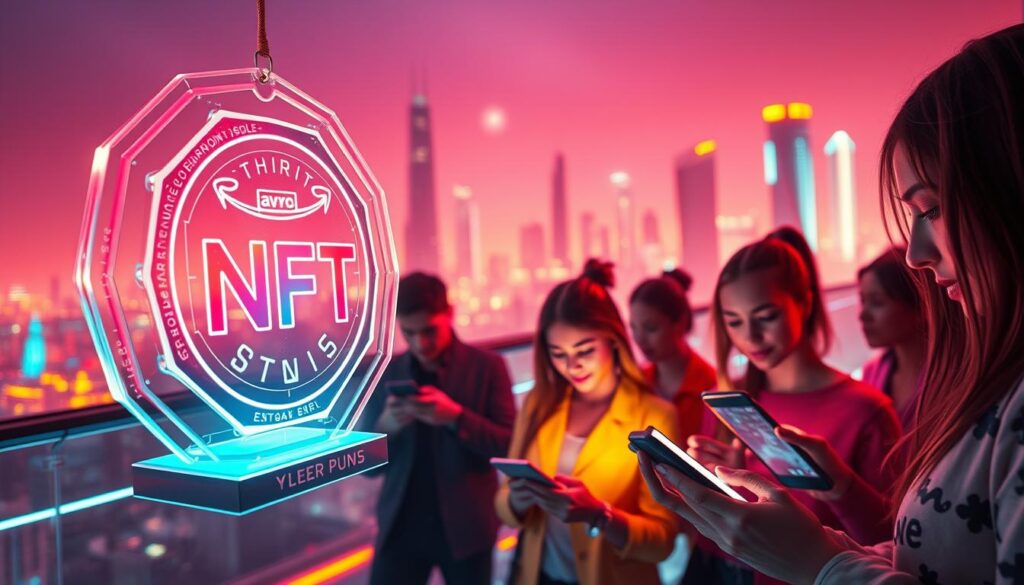Brands are shifting reward systems from anonymous points into unique, on-chain assets that prove ownership and add real scarcity. This short guide lays out a clear path for U.S. businesses to move toward nft loyalty options while keeping customer experience simple and secure.
We’ll cover model choice, blockchain and token standards, mechanics like tiers and token-gating, and integrations that support walletless checkout. Real-world examples show the gains: Starbucks Odyssey issues collectible “stamps” and lets members buy without a crypto wallet, while Clinique ran a social raffle that rewarded winners with collectible art and products.
Sustainability and compliance matter. Pick efficient chains, state clear privacy terms, and measure retention, lifetime value, and community growth from day one. This approach keeps the system flexible for gaming, e-commerce, and other media without rebuilding the core.
Key Takeaways
- Unique on-chain rewards replace generic points and build status.
- Select chains for scalability, fees, security, and environmental impact.
- Design for accessibility with walletless purchase and clear UX.
- Measure retention, LTV, and rarity use to guide optimization.
- Communicate sustainability and privacy to protect brand trust.
Why NFT loyalty now: aligning brand value and customer engagement in the present
Today’s buyers want recognition, rarity, and perks that feel exclusive and earned. Digital collectibles offer verifiable ownership, clear scarcity, and social signals that match these expectations.

User intent and what customers expect
Customers seek status and meaningful rewards. Personalized tokens can evolve as purchase habits change, giving a sense of progress.
Quick wins: personalization, exclusivity, and ownership
Quick wins include limited drops, exclusive digital art tied to purchases, and token-gated content that adds immediate perceived value.
- Exclusivity: Controlled supply keeps rewards desirable.
- Social proof: Shareable items boost organic reach.
- Accessibility: Walletless starts and credit-card checkout widen participation.
| Benefit | Example | Business impact |
|---|---|---|
| Scarcity | Limited-edition drops (Estée Lauder) | Higher perceived value; stronger retention |
| Personalization | Promo art tied to purchase history | Improved lifetime value and repeat buys |
| Shareability | Social badges and story mechanics (Clinique) | Organic referral and brand awareness |
Maintain fairness with occasional open raffles alongside elite drops. Communicate scarcity clearly to avoid backlash and build trust. For a practical setup guide, see the implementation overview.
Mapping the right loyalty model before you mint
Start by mapping which reward structure best fits your offer and audience.
Points, paid, value, and tier models
Compare four options and pick the one that matches customer behavior. Points replace generic credits with collectible tokens that reward frequent buys. Paid memberships sell ongoing perks and suit premium brands. Value models tie tokens to causes and build mission-driven engagement. Tiered setups (Bronze/Silver/Gold) push long-term ascension.
Design rewards customers actually want
Translate token utility into clear benefits: exclusive product access, VIP events, hands-on workshops, or limited collectibles linked to hero items. Decide if assets are transferable for collector markets or non-transferable when benefits represent earned status.

Brand case cues and practical governance
Use Starbucks Odyssey’s activity stamps as a playbook: activity-based stamps that unlock perks and allow credit-card onramp. Clinique’s raffle shows social storytelling, tight scarcity, and bundling with best-selling products.
- Start with a pilot aligned to existing data, then expand to hybrids.
- Set rarity schedules, perk inventory, and seasonal drops to avoid oversupply.
- Measure redemption, tier ascension speed, and incremental lifetime value.
| Model | Best fit | Key NFT benefit | Measurement |
|---|---|---|---|
| Points | Frequent-purchase categories | Personalized, tradable tokens | Redemption rate; repeat frequency |
| Paid | Premium / subscription brands | Guaranteed perks; recurring revenue | Retention; membership growth |
| Value | Mission-led companies | Cause-linked participation | Engagement; brand sentiment |
| Tiered | Long-term engagement plays | Escalating status and perks | Ascension velocity; LTV uplift |
Legal review and customer support readiness matter—especially for raffles and on-chain queries. For examples and deeper comparisons, see best nft loyalty programs for U.S. brands.
Choosing your blockchain and token standards for scale
Choosing a blockchain and token standard is a strategic move that affects security, speed, and brand trust. Early decisions shape fees, integrations, and the member experience across campaigns and long-term offerings.

Platform criteria: practical checklist
- Scalability & fees: pick networks that handle high-volume drops with low transaction costs.
- Security: prioritize chains with strong tooling, audits, and active developer communities.
- Interoperability: select ecosystems that support bridges, wallets, and partner integrations.
- Environmental impact: favor energy-efficient networks and communicate choices clearly.
ERC-1155 for hybrid rewards
ERC-1155 supports fungible and non-fungible items in one contract. That lets teams batch transfers, cut gas, and simplify inventory management for large cohorts.
Soulbound tokens for non-transferable status
Use soulbound tokens when status must stay earned and non-marketable—tier badges, certifications, or event access. These preserve exclusivity and reduce resale risks.
- Choose upgradeable, audited contracts and clear key-management policies.
- Plan custodial vs. non-custodial and offer walletless on-ramps for mainstream adoption.
- Security checklist: third-party audits, allowlists for minting, and active monitoring.
Designing your NFT mechanics for loyalty that lasts
Design mechanics that reward participation and preserve exclusivity through clear tier rules and gated access.

Layered tiers that evolve
Map Bronze, Silver, Gold thresholds and state what earns an upgrade. Use simple rules that tie on-chain ownership and off-chain purchase history to automatic promotions.
Early access windows reserved for higher tiers amplify desirability and drive repeat visits.
Token-gating for exclusive content and events
Limit product preorders, content hubs, and event RSVP lists to specific token holders. Token-gating makes perks tangible and enforces scarcity without manual checks.
Dynamic membership NFTs and branded profile art
Let artwork and metadata evolve with spend or participation. Visual progress and branded profile art encourage sharing and build community identity.
Programmable royalties that fund rewards
Set a share of secondary sale royalties to flow into a treasury. Reinvest that pool in perks, events, or creator grants to sustain momentum and align collector incentives.
- Define upgrade triggers: purchases, referrals, or milestone activities.
- Publish rarity calendars and seasonal refresh dates.
- Protect exclusivity with issuance caps and clear portability rules.
| Mechanic | Purpose | Business outcome |
|---|---|---|
| Tiered NFTs (Bronze/Silver/Gold) | Drive ascension and repeat engagement | Higher retention; clearer VIP funnel |
| Token-gated drops | Protect limited inventory and events | Increased conversion for premium items |
| Dynamic artwork | Signal member progress publicly | Boosts social sharing and referrals |
| Royalty-backed treasury | Fund ongoing rewards and experiences | Self-funding reward cycle; longer program life |
Integration playbook: extend utility beyond your program
Expand token utility across play, social, finance, and commerce to lift engagement and retention.
Gaming and VR integrations let tokens unlock skins, boosts, or private rooms. Use ERC-1155 where items mix fungible and unique assets for efficient batch drops. Virtual lounges and demos create immersive experiences and repeat visits.
Social integrations boost discovery. Allow profile badges, verified displays, and shareable content that show membership status and spark organic reach.
- DeFi: consider staking assets for yield, but provide clear risk guides.
- E-commerce: enable token-gated pages, automatic discounts, and early access at checkout.
- Cross-platform: design portable tokens so benefits stack across partners.
Technical notes: verify ownership server-side via APIs or middleware. Document metadata standards and offer opt-in privacy controls. Track usage across channels to find high-value integrations and refine rewards.
| Channel | Use case | Token type | Business gain |
|---|---|---|---|
| Gaming & VR | Skins, inventory slots, private spaces | ERC-1155 mixed assets | Higher engagement; longer sessions |
| Social | Profile badges, unlockable content | Non-transferable badges or tradable art | Increased referrals and social proof |
| DeFi | Staking for additional rewards | Tokenized stakeable assets | New incentive layer; retention |
| E‑commerce | Member-only drops and checkout perks | Cross-platform utility tokens | Higher conversion and LTV |
How to create NFT loyalty program with irresistible incentives
Turn perks into collectible passes that grant priority access and tangible benefits.
Exclusive NFT coupons and early access that drive FOMO
Design limited-run ERC-1155 coupons that act as verifiable VIP passes. Set supply caps and expirations to increase urgency and perceived value.
Staged priority windows reward higher tiers—Gold might get 48 hours, Silver 24 hours—so members feel progress and gain real access.
Batch-transfer points for fast, low-cost distribution
Use ERC-1155 batch transfers to send points or reward tokens to thousands of users in a single transaction. This reduces fees and speeds delivery after campaigns.
Batching simplifies accounting and keeps the user experience smooth when many guests earn rewards at once.
Gamified levels, storytelling, and community building
Build quests (watch, learn, buy, refer) that issue evolving NFTs reflecting progress. Evolving art and metadata create a sense of ownership and uniqueness.
Host token-gated AMAs and co-creation polls so members help shape future drops. That community input strengthens brand ties and long-term engagement.
- Bundle digital passes with exclusive product bundles or VIP support.
- Mix predictable drops with surprise flash quests to keep momentum.
- Offer one-click verify-and-apply redemption at checkout for low friction.
| Incentive | Mechanic | Benefit |
|---|---|---|
| Exclusive coupons | ERC-1155 limited runs | Higher conversion; FOMO-driven sales |
| Batch points | Batch transfers after campaigns | Lower fees; rapid fulfillment |
| Gamified NFTs | Evolving art & milestone rewards | Increased engagement; retention uplift |
For a practical launch playbook and integration tips, see this guide.
From concept to launch: build, integrate, and communicate
Move from concept to launch with a focused plan that balances tech, UX, and member communications.
Start small. Build an MVP that includes minting, ownership checks, token-gating, and redemption flows. Prioritize a frictionless checkout: credit-card purchases and deferred wallet creation remove barriers for customers.
Use clear, visual onboarding that explains utility, claiming steps, and redemption without crypto jargon. Include email/SSO signup, guided walkthroughs, and one-click verify actions for low friction.
Pilot, iterate, and scale with transparent updates
Run a controlled pilot with a defined cohort. Test incentives, batch distribution, and support workflows before wider rollout.
Create a cadence of prelaunch teasers, launch explainers, newsletters, and AMAs. Spotlight members and share stories to build social proof and strengthen the brand.
- Support: publish FAQs and playbooks for wallet questions and lost access.
- Analytics: track enrollments, activations, and redemptions.
- Compliance: coordinate legal on terms and privacy.
Plan a phased rollout: expand perks, add integrations, and iterate on tiers based on real customer feedback and performance data.
Measure, optimize, and mitigate risks as you scale
Track outcomes with an integrated dashboard that links on-chain ownership and off-chain behavior. That single view helps businesses spot retention lifts, LTV shifts, and changes in redemption patterns fast.
Engagement KPIs and experimentation
Core metrics: active holders, retention, lifetime value, rarity utilization, redemption rate, and referral impact. Compare cohorts that have token-gated access versus those that do not.
Run controlled tests that vary scarcity, perk bundles, and storytelling. Use points-based bidding for ultra-limited nfts to drive fair competition without inflating supply.
Sustainability and operational controls
Choose energy-efficient chains and publish the rationale. Monitor sentiment and report ongoing impact efforts to customers and stakeholders.
Governance, cadence, and compliance
Set frequency caps, seasonal themes, and transparent drop calendars. Publish clear terms about asset utility and transferability. Add age gating, eligibility rules, and anti-bot protections.
| KPI | What to track | Action |
|---|---|---|
| Retention | 30/90 day active holders | Adjust tier triggers; run re-engagement quests |
| Rarity utilization | Percent of rare assets redeemed | Rebalance supply; introduce bidding with points |
| Redemption rate | Claimed coupons and discounts | Simplify checkout; one-click verify |
| Secondary market | Price trends and volume | Reinvest royalties; adjust scarcity |
Prepare an incident response for contract updates and exploits, and keep community channels ready. For a practical launch checklist and further reading, see the nft loyalty playbook.
Leveling up loyalty: a future-ready roadmap for brands and customers
Plan a clear 12–18 month path that moves pilots into scalable rewards across platforms. Start with a tight pilot, prove core mechanics, then add partnerships and cross‑platform utility so perks travel into gaming, social, and e‑commerce.
Invest in interoperability and wallet abstraction. Allocate royalty revenue for ongoing perks, creator collaborations, and live events that keep members engaged. Mix collectibles, access passes, education, and impact rewards to match different motives.
Advance UX with better mobile flows and embedded verification at checkout and events. Build predictive measurement for churn and LTV by tier, expand governance inputs for holder-led choices, and keep sustainability visible in your communications.
Over time, nfts become durable membership infrastructure that amplifies brand value and customer trust. Brands like Starbucks and Clinique show accessible on‑ramps and high impact when tech, creativity, and clear benefits align for customers and businesses.
FAQ
Q: What is an NFT loyalty program and why does it matter for brands?
A: An NFT loyalty program issues unique digital tokens that grant holders real benefits — early access, exclusive products, or VIP experiences. This gives customers ownership, deepens engagement, and creates scarce digital assets that strengthen brand value and community over time.
Q: What customer expectations should brands meet when launching these initiatives?
A: Customers expect clear value, simple onboarding, and meaningful perks. They want personalization, transparent utility for tokens, and easy ways to redeem or showcase assets. Fast support and clear privacy terms are essential for trust.
Q: Which models work best: points, paid tiers, collectibles, or access-based systems?
A: The best fit depends on your market. Points work for frequent transactions, paid tiers suit premium audiences, collectibles spark community interest, and access-based models reward top fans. Mix elements for flexibility and long-term retention.
Q: How do successful U.S. brand examples inform program design?
A: Look at Starbucks Odyssey for stamp-based engagement and Clinique’s raffle approach for product launches. These examples show blending digital collectibles with real-world rewards, clear UX, and strong storytelling drives adoption.
Q: Which blockchain features should guide platform choice?
A: Prioritize scalability, security, low fees, and broad interoperability. Also weigh ecosystem tools, wallet support, and environmental impact. The right chain reduces friction and keeps ongoing costs predictable.
Q: When should a brand use ERC-1155 or soulbound tokens?
A: Use ERC-1155 for hybrid items, batch transfers, and low-cost minting of multiple assets. Choose soulbound tokens for nontransferable status markers like verified VIP memberships that preserve scarcity and community integrity.
Q: How can tiers and token-gating improve long-term engagement?
A: Layered tiers offer progression, with each level unlocking stronger perks. Token-gating grants access to events, drops, and content, creating clear incentives for continued interaction and higher lifetime value.
Q: What mechanics increase perceived value without huge spend?
A: Exclusive coupons, early access, storytelling events, and limited-run items drive FOMO and loyalty. Gamified milestones and community challenges add social value without large financial outlays.
Q: How do brands extend utility outside the program?
A: Integrate tokens with e-commerce, social platforms, gaming, and virtual spaces. Offer cross-platform benefits, allow staking for yields, and create shareable experiences that amplify reach and utility.
Q: What are best practices for onboarding customers who don’t use crypto wallets?
A: Offer credit-card checkout, custodial wallets, or one-click account creation. Provide clear guides, in-app support, and instant customer service to reduce drop-off and increase conversion.
Q: How should companies pilot and iterate before full launch?
A: Start with a small, engaged cohort, monitor engagement KPIs like retention and redemption, collect feedback, and refine assets and UX. Use transparent communication and member spotlights to build momentum.
Q: Which KPIs matter most for measuring success?
A: Track retention, lifetime value, redemption rate, rarity utilization, and referral activity. Monitor community growth and secondary-market behavior if assets are transferable.
Q: How can brands reduce environmental and regulatory risks?
A: Choose energy-efficient chains, disclose carbon impact, and build compliance into onboarding and rewards. Work with legal counsel on consumer protections, tax treatment, and anti-fraud safeguards.
Q: What role do programmable royalties and fees play?
A: Programmable royalties let brands recapture value on resales and fund future rewards. They create ongoing revenue streams that support ecosystem growth and member benefits.
Q: How do you keep exclusivity without alienating casual customers?
A: Offer layered access: public drops for broad engagement, limited editions for superfans, and time-limited perks that reward activity. Maintain affordable entry points to nurture future high-value members.
Q: What makes a rewards catalog compelling and sustainable?
A: Mix digital collectibles, physical goods, experiences, and financial incentives. Prioritize high-perceived value items that scale, and refresh offerings regularly to maintain excitement and utility.
Q: How can brands prepare for scaling and fraud prevention?
A: Implement monitoring tools, anti-bot measures, and clear transfer rules. Plan infrastructure for peak demand, use reputable custodial partners, and document operations for transparency.
Q: What does a future-ready roadmap include for long-term loyalty?
A: Roadmaps should evolve with member feedback, add interoperable utility, deepen social features, and explore partnerships across media, gaming, and retail. Prioritize modular systems that adapt as technology and community needs change.


No comments yet